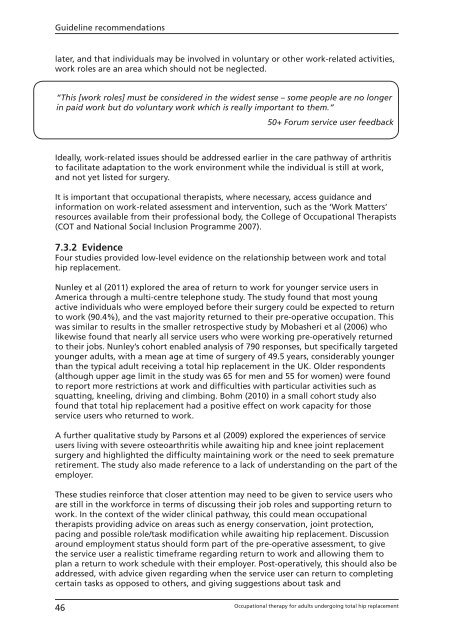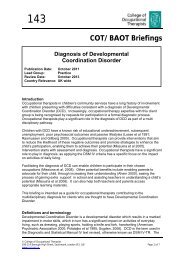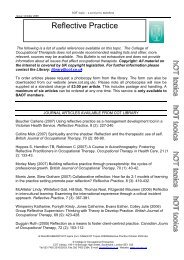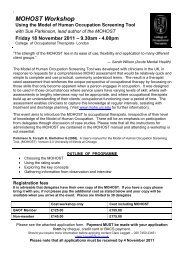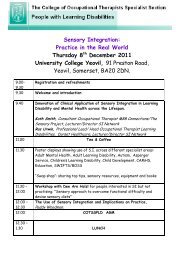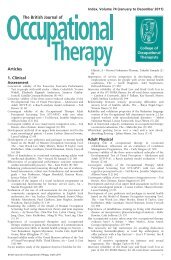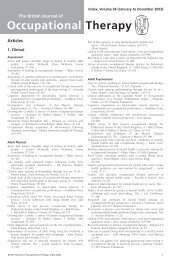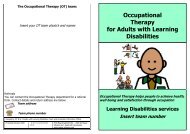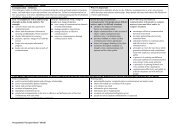Total hip replacement - College of Occupational Therapists
Total hip replacement - College of Occupational Therapists
Total hip replacement - College of Occupational Therapists
Create successful ePaper yourself
Turn your PDF publications into a flip-book with our unique Google optimized e-Paper software.
Guideline recommendations<br />
later, and that individuals may be involved in voluntary or other work- related activities,<br />
work roles are an area which should not be neglected.<br />
“This [work roles] must be considered in the widest sense – some people are no longer<br />
in paid work but do voluntary work which is really important to them.”<br />
50+ Forum service user feedback<br />
Ideally, work- related issues should be addressed earlier in the care pathway <strong>of</strong> arthritis<br />
to facilitate adaptation to the work environment while the individual is still at work,<br />
and not yet listed for surgery.<br />
It is important that occupational therapists, where necessary, access guidance and<br />
information on work- related assessment and intervention, such as the ‘Work Matters’<br />
resources available from their pr<strong>of</strong>essional body, the <strong>College</strong> <strong>of</strong> <strong>Occupational</strong> <strong>Therapists</strong><br />
(COT and National Social Inclusion Programme 2007).<br />
7.3.2 Evidence<br />
Four studies provided low-level evidence on the relations<strong>hip</strong> between work and total<br />
<strong>hip</strong> <strong>replacement</strong>.<br />
Nunley et al (2011) explored the area <strong>of</strong> return to work for younger service users in<br />
America through a multi- centre telephone study. The study found that most young<br />
active individuals who were employed before their surgery could be expected to return<br />
to work (90.4%), and the vast majority returned to their pre- operative occupation. This<br />
was similar to results in the smaller retrospective study by Mobasheri et al (2006) who<br />
likewise found that nearly all service users who were working pre- operatively returned<br />
to their jobs. Nunley’s cohort enabled analysis <strong>of</strong> 790 responses, but specifically targeted<br />
younger adults, with a mean age at time <strong>of</strong> surgery <strong>of</strong> 49.5 years, considerably younger<br />
than the typical adult receiving a total <strong>hip</strong> <strong>replacement</strong> in the UK. Older respondents<br />
(although upper age limit in the study was 65 for men and 55 for women) were found<br />
to report more restrictions at work and difficulties with particular activities such as<br />
squatting, kneeling, driving and climbing. Bohm (2010) in a small cohort study also<br />
found that total <strong>hip</strong> <strong>replacement</strong> had a positive effect on work capacity for those<br />
service users who returned to work.<br />
A further qualitative study by Parsons et al (2009) explored the experiences <strong>of</strong> service<br />
users living with severe osteoarthritis while awaiting <strong>hip</strong> and knee joint <strong>replacement</strong><br />
surgery and highlighted the difficulty maintaining work or the need to seek premature<br />
retirement. The study also made reference to a lack <strong>of</strong> understanding on the part <strong>of</strong> the<br />
employer.<br />
These studies reinforce that closer attention may need to be given to service users who<br />
are still in the workforce in terms <strong>of</strong> discussing their job roles and supporting return to<br />
work. In the context <strong>of</strong> the wider clinical pathway, this could mean occupational<br />
therapists providing advice on areas such as energy conservation, joint protection,<br />
pacing and possible role/task modification while awaiting <strong>hip</strong> <strong>replacement</strong>. Discussion<br />
around employment status should form part <strong>of</strong> the pre- operative assessment, to give<br />
the service user a realistic timeframe regarding return to work and allowing them to<br />
plan a return to work schedule with their employer. Post- operatively, this should also be<br />
addressed, with advice given regarding when the service user can return to completing<br />
certain tasks as opposed to others, and giving suggestions about task and<br />
46<br />
<strong>Occupational</strong> therapy for adults undergoing total <strong>hip</strong> <strong>replacement</strong>


